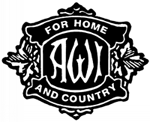About AWI
The Alberta Women's Institutes (AWI) is one of the oldest voluntary associations for women in the Province of Alberta. As a latter-day instance of the Mechanics Institutes movement, the Women's Institutes aimed at improving society, through improving the individual. Accordingly, the objectives of the Women's Institutes are to help rural women acquire home management and leadership skills; strengthen communities through active involvement; and build mutually beneficial social networks.
The first individual WI branch was organized at Lea Park in 1909 by Martha Graham, who had emigrated to Alberta from Ontario, where the Women’s Institutes had begun in 1897. The AWI’s primary goal in the early twentieth century was to provide emotional and intellectual support to the thousands of women who had settled in the new province of Alberta. Many of these women had no agricultural experience and were living many miles from other women, in primitive conditions on isolated farms. The Institutes provided an opportunity to meet with other women once each month.
Beginning in 1907, the provincial government began to offer short courses in agriculture to farmers across the province. Farm wives had been attending these courses, especially the poultry and dairy lectures. In 1912, the government hired Roberta MacAdams, a home economist from Ontario, to survey the needs of rural women. Her report led to the establishment of the AWI as a province-wide, government-sponsored program of adult education for rural women. One of the principle ways of providing this education was the agricultural demonstration train, which offered lectures, demonstrations and exhibits to men. After 1912, these trains included a separate car dedicated to the needs of farm women. The very existence of these trains, and the distance education they provided, promoted the establishment of more local AWI branches. By the 1920s, there were over 250 branches representing 15,000 members across the province.
The effects of the AWI on community life in Alberta are significant. As a non-sectarian, non-partisan organization, it was able to attract members from across the religious and political spectrum. Since AWI branches were organized in small communities, the members were able to identify local needs for social infrastructure. The organization soon became one of the most effective rural fund-raisers in the province for the establishment of libraries, hospitals, community halls, rest rooms, and cemeteries.
Once local infrastructure was in place, the AWI continued its fund-raising activities by offering scholarships to young women, sending care packages to Canadian servicemen in both world wars, supplying food and supplies to Britain during wartime, supporting the purchase of radiation sticks for cancer therapy, serving as the fund-raising vehicle for the Red Cross, and supporting aboriginal women’s groups. Over time, the AWI became a point group for such government programs as farm safety.
But it is the effects of the AWI on the lives of individual women that is a key focus of this website. The organization’s focus on leadership and political education provided an ideal platform for some of its early members to pursue public lives. A great many AWI members served on school, church, and hospital boards, on municipal councils, as magistrates, and in the legislature. Prominent AWI members have included, Nellie McClung, Emily Murphy, Martha Bielish, and Cornelia Wood. The sense of achievement and fellowship that have sustained this organization for a century are evident in the documents presented on this website, especially in the Books of Remembrance, the interviews and the personal recollections of its members.

